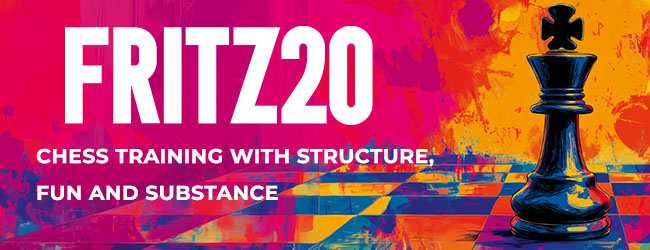Suspicion — or pure desperation
On August 18th 1972, exactly 45 years ago, the 15th game ended and Fischer had retained his three-point lead.

In Chess Life & Review December 1972, p.749, GM Svetozar Gligoric wrote: "When Spassky, as challenger, was to capture Petrosian's title in 1969, he prepared for three months. For the match with Fischer in 1972, as champion, he prepared for eight months. What was hidden in all those weeks of hard self-discipline was not fully disclosed in the beginning of the match. How did that happen? Fischer cleverly avoided all lines which might have been expected from him. There was no prepared variation which Spassky could apply. For Fischer did not employ the Gruenfeld nor the King's Indian and, with White, even stopped opening with his hitherto favorite King's Pawn. The titleholder found himself in a desert without knowing in which direction to go..."
Minute advantages
In Chess Life & Review December 1972, p. 743, Robert Byrne writes about game 16:
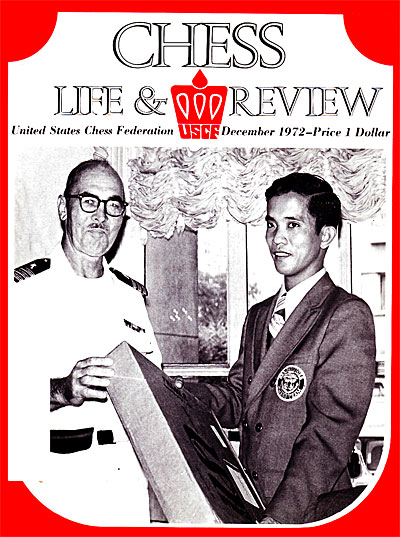 "Fischer chose the quiet, positional course of the Barendregt Variation of the Ruy Lopez to lead off game 16. It seemed at first as though White could count on some advantage in the endgame resulting from Black's doubled pawns, but once again Spassky came up with an interesting theoretical innovation to obtain counterplay. He achieved a plus so minute that Fischer could not be stopped from forcing a well-known drawn Rook-and-pawn ending with two pawns against one.
"Fischer chose the quiet, positional course of the Barendregt Variation of the Ruy Lopez to lead off game 16. It seemed at first as though White could count on some advantage in the endgame resulting from Black's doubled pawns, but once again Spassky came up with an interesting theoretical innovation to obtain counterplay. He achieved a plus so minute that Fischer could not be stopped from forcing a well-known drawn Rook-and-pawn ending with two pawns against one.
The game could have been given up as a draw as early as the 24th move, but Boris, perhaps annoyed that Bobby had brought him in to play the few obvious moves of the perpetual check in the previous games adjournment session, insisted on dragging out the routine all the way to the 60th move. In fact, he waited until Bobby was ready to stick the sealed move into the envelope before offering the draw."
| Replay and check the LiveBook here |
Please, wait...
1.e4 e5 2.Nf3 Nc6 3.Bb5 a6 4.Bxc6 dxc6 5.0-0 5.d4 exd4 6.Qxd4 Qxd4 7.Nxd4 5...f6 6.d4 Bg4 7.dxe5 Qxd1 8.Rxd1 fxe5 9.Rd3 Bd6 10.Nbd2 Nf6 11.Nc4 Nxe4 12.Ncxe5 Bxf3 12...Bf5? 13.g4! Be6 14.Re3 Nf6 15.Ng5 13.Nxf3 0-0 14.Be3 b5! 15.c4? 15.Nd2 Nxd2 15...Nf6 16.Nb3 15...Nc5 16.Bxc5 16.Rc3 16...Bxc5 17.Ne4 Bb6 18.Re1 Rae8 19.Kf1 16.Rxd2 c5 17.c4 15...Rab8! 16.Rc1 16.b3 Ba3 16...bxc4 17.Rd4! 17.Rd7 17.Rad1 bxc4 18.bxc4 Bd6 19.Rb3 Rxb3 20.axb3 Rb8 21.Rd3 a5 22.g3 17...bxc4 18.bxc4 Bd6! 19.Bd4 Nf6 20.Bxf6 Rxf6 16...bxc4 17.Rd4 17.Rxc4 Rxb2 17...Rfe8 18.Nd2 18.Rc2 c3! 19.bxc3 Rb1+ 20.Bc1 Ng5! 21.Rd1 Nxf3+ 22.gxf3 18...Nxd2 19.Rxd2 Re4 20.g3 Be5 21.Rcc2 Kf7 22.Kg2 Rxb2! 23.Kf3 23.Rxb2 c3 23...c3 24.Kxe4 cxd2 25.Rxd2 Rb5 26.Rc2 Bd6 27.Rxc6 Ra5 28.Bf4! 28.Rc2 Ke6 28...Ra4+ 29.Kf3 Ra3+ 30.Ke4 Rxa2 31.Bxd6 cxd6 32.Rxd6 Rxf2 33.Rxa6 Rxh2 34.Kf3 Rd2 35.Ra7+ Kf6 36.Ra6+ Ke7 37.Ra7+ Rd7 38.Ra2 Ke6 39.Kg2 Re7 40.Kh3 Kf6 41.Ra6+ Re6 42.Ra5 h6 43.Ra2 Kf5 44.Rf2+ Kg5 45.Rf7 g6 46.Rf4 h5 47.Rf3 Rf6 48.Ra3 Re6 49.Rf3 Re4 50.Ra3 Kh6 51.Ra6 Re5 52.Kh4 Re4+ 53.Kh3 Re7 54.Kh4 Re5 55.Rb6 Kg7 56.Rb4 Kh6 57.Rb6 Re1 58.Kh3 Rh1+ 59.Kg2 Ra1 60.Kh3 Ra4 ½–½ - Start an analysis engine:
- Try maximizing the board:
- Use the four cursor keys to replay the game. Make moves to analyse yourself.
- Press Ctrl-B to rotate the board.
- Drag the split bars between window panes.
- Download&Clip PGN/GIF/FEN/QR Codes. Share the game.
- Games viewed here will automatically be stored in your cloud clipboard (if you are logged in). Use the cloud clipboard also in ChessBase.
- Create an account to access the games cloud.
| Fischer,R | 2785 | Spassky,B | 2660 | ½–½ | 1972 | C69 | Reykjavik World Championship (16) | 16 |
Please, wait...
Game 17 ends in repetition
In Chess Life & Review Robert Byrne writes:
"Fischer surprised once more in the 17th game, defending for the first time in his career a Pire-Robatsch Defense, which he has always bruised badly himself when White. Spassky, in an adventurous mood, came on strong with a dangerous pawn sacrifice, bearing down on the enemy King's position with two powerful Bishops. Although it was not clear that the attack would succeed, Fischer chose to sacrifice the Exchange in order to simplify into a drawn ending. Because whatever chances were left belonged to White, Spassky's falling into a threefold repetition of the position right at the beginning of the second playing session seemed strange. Did he overlook the repetition or was he deliberately acquiescing to the draw? All I can say is that he looked unhappy when Chief Referee Lothar Schmid confirmed the repetition and the draw. It was certainly no great loss, for Fischer would pretty clearly have cinched the draw anyway. The score now good as 9-6 in favor of Fischer."
We bring you excerpts of Byrne's commentary:
| Replay and check the LiveBook here |
Please, wait...
1.e4 d6 2.d4 g6 3.Nc3 Nf6 4.f4 Bg7 5.Nf3 c5 5...0-0 6.Bd3 Nc6 6.dxc5 Qa5 6...dxc5? 7.Qxd8+ Kxd8 8.e5 7.Bd3 7.cxd6 Nxe4 7...Qxc5 8.Qe2 0-0 9.Be3 Qa5 9...Qb4?! 10.0-0-0? 10.0-0 Qxb2 11.Nb5 Ne8 12.e5 Qb4 13.Nxa7 10...Nxe4! 11.Bxe4 Bxc3 12.bxc3 Qxe4 10.0-0 Bg4 11.Rad1!? 11.a3 Bxf3 12.Qxf3 11...Nc6 12.Bc4 Nh5! 13.Bb3 Bxc3 14.bxc3 Qxc3 15.f5 Nf6 16.h3 Bxf3 17.Qxf3 Na5 18.Rd3 Qc7 19.Bh6 Nxb3 20.cxb3 20.Bxf8? Nc5 21.Bh6 Nxd3 20...Qc5+ 21.Kh1 Qe5?! 22.Bxf8 Rxf8 23.Re3 Rc8 24.fxg6? hxg6 25.Qf4 Qxf4 26.Rxf4 Nd7 27.Rf2 Ne5 28.Kh2 Rc1 29.Ree2 Nc6 30.Rc2 Re1 31.Rfe2 Ra1 32.Kg3 Kg7 33.Rcd2 Rf1 34.Rf2 Re1 35.Rfe2 Rf1 36.Re3 a6 37.Rc3 Re1 38.Rc4 Rf1 39.Rdc2 Ra1 40.Rf2 Re1 41.Rfc2 g5 42.Rc1 Re2 43.R1c2 Re1 44.Rc1 Re2 45.R1c2 ½–½ - Start an analysis engine:
- Try maximizing the board:
- Use the four cursor keys to replay the game. Make moves to analyse yourself.
- Press Ctrl-B to rotate the board.
- Drag the split bars between window panes.
- Download&Clip PGN/GIF/FEN/QR Codes. Share the game.
- Games viewed here will automatically be stored in your cloud clipboard (if you are logged in). Use the cloud clipboard also in ChessBase.
- Create an account to access the games cloud.
| Spassky,B | 2660 | Fischer,R | 2785 | ½–½ | 1972 | B09 | Reykjavik World Championship (17) | 17 |
Please, wait...
In the magazine New in Chess vol 6/2012, GM Lubomir Kavalek, who was in Reykjavik for the Match of the Century, both as a journalist and, in the second half, as one of Fischer’s seconds, describes what happened during the adjournment: "In Game 17 Bobby gave up an exchange, but was able to build a fortress. Spassky’s only chance to play for win was to give back the exchange and go to a rook endgame. ‘The only way to find out is to allow it,’ Bobby said after we began our analysis. His fingers moved across the chessboard quickly and the clumsy rooks began to fly. At one point I thought the black rook should go behind the white pawns. ‘No,’ he said without hesitation, ‘the rook has to hit them from the side. I know that.’ Some players calculate endgames, others go by instinct. Bobby knew what to do."
Around this time Spassky's delegation head Nikolai Krogius though that Spassky's second Ivo Nei was behaving oddly, spending a lot of time alone with GM Robert Byrne. The book Bobby Fischer Goes to War by David Edmonds and John Eidinow (see below) describes the situation:
Nei was put under hostile interrogation. He did not deny his contacts with Byrne, that he and the American were analyzing the match and that he was passing Byrne his comments on the games for future publication in the United States.
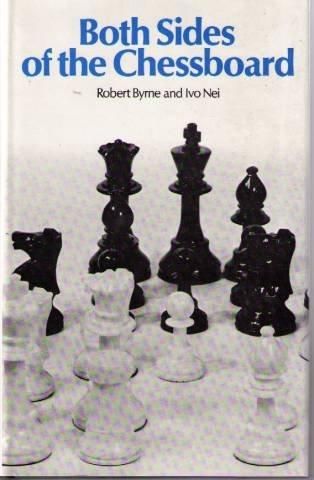
His dubious listeners pressed Nei: “Why was he engaged in outside work of such a suspicious nature, and in secret, without Spassky’s permission? And in the material passed to the American, what had he said about Spassky’s condition and his own assessment of Spassky’s chess to date?” They were not satisfied with Nei’s responses. The conversation grew extremely heated. Nei was told that his services were no longer required and that he must leave.
On the following day [game seventeen, on 22 August 1972] the Estonian flew out. Nei says that many people in the chess world were surprised to see him return to Estonia; they thought he would end up in Siberia or the West. But, he asks, why? He had not behaved incorrectly. From Tallinn, he went on to send his final contributions for the book to the States, in seven parts. He must have had some trepidation about the project: he posted each of these sections to separate addresses in Canada as well as the United States.
The resulting book by Robert Byrne and Ivo Nei, Both Sides of the Chessboard, published by Harper Collins, is available from AbeBooks.
Game 18
In Chess Life & Review January 1973 GM Robert Byrne continued his series on the Match of the Century. On page 17, taking up the narrative after game 17, he wrote: "Redoubled efforts by Boris Spassky to lop a point from the challenger's lead made for brilliant, hard-fought chess in the next stage of the match, which saw Fischer inching nearer and nearer to victory with draws in games 8, 19 and 20. Was Bobby content merely to sneak in by split points? I don't believe it—it's never been his style. I think the explanation for the draws is to be found in Spassky's improvements in his openings. In games 18 and 20, Boris returned to the Sicilian Defense which worked well for him in game 4. The 18th contest was a great struggle in which Black's chances were never inferior to White's.."
In New in Chess vol 6/2012 GM Lubomir Kavalek wrote: "Bobby was obsessed with winning and was not happy until he had exhausted all possibilities. This became clear when we analysed the adjourned position of Game 18. We soon realized that every winning attempt was doomed. The chances always tilted towards Spassky, but was Boris winning? Bobby’s eyes lit up when I suggested a queen manoeuvre, forcing Spassky to repeat moves. ‘Great! We have a draw. Let’s go for the win again,’ and we spent four more hours trying to find something that wasn’t there. For a single victory, Bobby could work himself to exhaustion."
| Replay and check the LiveBook here |
Please, wait...
1.e4 c5 2.Nf3 d6 3.Nc3 Nc6 4.d4 cxd4 5.Nxd4 Nf6 6.Bg5 6.Be2 e5 6...e6 7.Qd2 a6 8.0-0-0 Bd7 9.f4 Be7 10.Nf3 b5 11.Bxf6 11.e5 b4 12.exf6 bxc3 13.Qxc3 gxf6 14.Bh4 11...gxf6 11...Bxf6?! 12.Qxd6 Be7 13.Qd2 b4 14.Na4 Ra7 12.Bd3 Qa5 13.Kb1 b4 14.Ne2 Qc5 15.f5 a5 15...exf5? 16.exf5 Bxf5 17.Bxf5 Qxf5 18.Nf4 16.Nf4 a4 17.Rc1 Rb8 18.c3 b3 18...Ne5 19.Nd4 bxc3 20.Qxc3 Qxc3 21.Rxc3 Nxd3 22.Nxd3 19.a3 Ne5 20.Rhf1 20.fxe6 fxe6 21.Nd4 Kf7 21...Nc4 22.Qe2 Nxa3+ 23.bxa3 Qxa3 24.Nfxe6 Bxe6 25.Nxe6 b2 26.Bb5+ Kf7 27.Qh5+! Kg8 27...Kxe6 28.Qd5# 28.Rcf1 Qa1+ 29.Kc2 Qa2 30.Kd3 30.Qg4+ Kf7 31.Qg7+ Kxe6 32.Rxf6+ Bxf6 33.Qd7+ Ke5 34.Qf5# 30...Qxe6 31.Bc4 22.Be2 Ng6! 20...Nc4 21.Bxc4 Qxc4 22.Rce1 Kd8 23.Ka1?! 23.g4 23...Rb5 24.Nd4 Ra5 25.Nd3 Kc7 26.Nb4 h5 27.g3 Re5 27...h4 28.g4 28.Nd3 Rb8!? 29.Qe2 29.fxe6 fxe6 30.Nxe5 dxe5 31.Nf3 29...Ra5 30.fxe6?! 30.Nb4 Qxe2 31.Nxe2! 30...fxe6 31.Rf2? e5! 32.Nf5 Bxf5 33.Rxf5 d5! 34.exd5 34...Qxd5? 34...Rd8 35.Nf4 Qxe2 36.Rxe2 Kd6 37.Nxh5 Rxd5 38.Rf1 Kc7 39.Ree1 Rd2 40.h4 Bxa3 41.bxa3 Ra2+ 42.Kb1 Rdd2 35.Nb4 Qd7 36.Rxh5? 36.Qc4+! Kb6 37.Rxh5 Rd8 38.Rb1 Bxb4 39.Qxb4+ Rb5 40.Qh4! Qd3 41.Qxf6+ Ka5 42.Qg5 36...Bxb4 37.cxb4 Rd5 38.Rc1+ Kb7 39.Qe4 Rc8! 40.Rb1 40.Rxc8 Kxc8 41.Rh8+ Kc7 42.Rh7 Rd1+ 40.Rd1 40...Kb6 41.Rh7 Rd4! 42.Qg6 Qc6 43.Rf7 Rd6 44.Qh6! Qf3 44...-- 45.Qe3+ Rd4 46.Qf2 45.Qh7 Qc6 45...Rd1 46.Rxf6+ 46.Qh6 Qf3 47.Qh7 Qc6 ½–½ - Start an analysis engine:
- Try maximizing the board:
- Use the four cursor keys to replay the game. Make moves to analyse yourself.
- Press Ctrl-B to rotate the board.
- Drag the split bars between window panes.
- Download&Clip PGN/GIF/FEN/QR Codes. Share the game.
- Games viewed here will automatically be stored in your cloud clipboard (if you are logged in). Use the cloud clipboard also in ChessBase.
- Create an account to access the games cloud.
| Fischer,R | 2785 | Spassky,B | 2660 | ½–½ | 1972 | B69 | Reykjavik World Championship (18) | 18 |
Please, wait...
Lights and chairs – suspicion of tampering
The book Bobby Fischer Goes to War by David Edmonds and John Eidinow, first edition 2004 by Harper Collins, describes the mood of the Soviet side at this stage of the match:
 In Moscow, at the end of July, apprehension over Spassky’s performance was running at a high level... There is a proposal to send the champion Kogitum—a medicine against nervous tension—and some exasperation at his refusal to take it. One report to have reached the KGB was that Fischer was being assisted by a computer (in Russian called an IBM—a Soviet tribute to American big business) and a device in his chair. There have already been reports in the Western press of Fischer being computer aided, reports derisively dismissed in Reykjavik by Spassky, Geller, and Krogius. Back in Moscow, the KGB does not believe silicon-based shenanigans are any more practical. A Comrade Lvov, a KGB technical officer, explains to the deputy minister that Fischer would have needed a full year to develop the requisite computer program and would have to have a portable receiver and a membrane in his ear to receive the signals.
In Moscow, at the end of July, apprehension over Spassky’s performance was running at a high level... There is a proposal to send the champion Kogitum—a medicine against nervous tension—and some exasperation at his refusal to take it. One report to have reached the KGB was that Fischer was being assisted by a computer (in Russian called an IBM—a Soviet tribute to American big business) and a device in his chair. There have already been reports in the Western press of Fischer being computer aided, reports derisively dismissed in Reykjavik by Spassky, Geller, and Krogius. Back in Moscow, the KGB does not believe silicon-based shenanigans are any more practical. A Comrade Lvov, a KGB technical officer, explains to the deputy minister that Fischer would have needed a full year to develop the requisite computer program and would have to have a portable receiver and a membrane in his ear to receive the signals.
Lvov is also the bearer of other shadowy news: he reports the possibility that Spassky has had a letter threatening his family if he returns to Moscow a winner. This is investigated, and no proof of its existence is found. The provenance of this letter is unclear; today, Spassky says he had no knowledge of it.
Other means of defending Spassky are afoot. As July turns into August, an unnamed forensic psychiatrist takes part in a meeting with Lvov and Gostiev. Lvov is all set to organize a check for radiation from radio waves and X-rays “on the spot” — presumably in the hall.
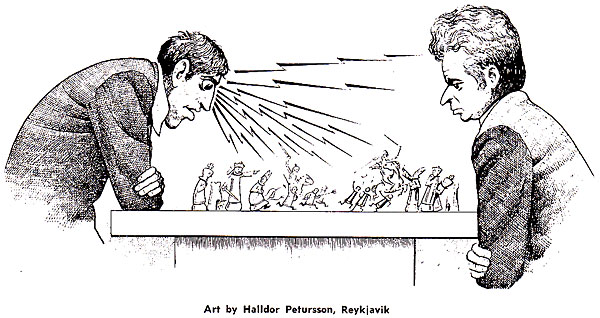
Throughout this period, the possibility of Spassky’s being the target of hypnosis and telepathy is being discussed. There is a hint that sending a psychiatrist to Reykjavik... Then there is the alarm over Spassky’s refreshments—that on 15 August he drank some juice and was overcome with lethargy... A sample is sent to Moscow. KGB scientists check the sample — nothing untoward was found.
However, the KGB is not content to play a purely reactive role. The organization’s idea of a helping hand also involves taking the initiative, instigating its own rumor that Fischer is cheating through a device hidden in his chair—a device, so the rumor goes, that is impairing Spassky’s performance and/or benefiting Fischer.
In his August 25 report for the New York Times — filed on Aug. 24, when game 18 was still in adjournment — Harold Schonberg wrote:
Earlier today, two Icelandic scientists were brought into Exhibition Hall to investigate the charges of electronic and chemical trickery made yesterday by Efim Geller of the Soviet delegation... Sigmundur Gudbjarnason, a professor of chemistry, and Dadi Augustin, an electronics engineer, were asked to survey the hall. Mr. Augustin made a visual and technical inspection of the lighting, about which Geller was suspicious, and the only thing he discovered were two dead flies. He concluded that there had been no tampering with the lights.
Mr. Augustin also brought X-ray equipment to the stage and took pictures of the chairs, especially Fischer's. Geller had wondered why Fischer always insisted on his own chair. After the X-ray report, Mr. Augustin was able to testify that Fischer's chair was identical in every respect with Spassky's. There was nothing unusual inside either chair.
After subjecting scrapings of both chairs to chemical analysis and gas chromography, Mr. Gudbjarnason decided that no alien or toxic chemicals were present in any body residue of either player. No Russians were present while the chemical and electronic analyses were being made, but Donald Schultz of the United States delegation was on hand.

Advert in Chess Life and Review. This book is still available, used, for less than $2.
In Bobby Fischer Goes to War, David Edmonds and John Eidinow write:
It remains an open question whether a KGB operative planted something in Fischer’s chair for the X-rays to pick up, part of an inept attempt to rescue the champion’s reputation, perhaps even to have Fischer disgraced and disqualified. Strikingly, even the American Don Schultz, an IBM engineer by profession and president of the USCF from 1996 to 1999, is suspicious. During the X-ray process, Fischer’s team sent Schultz along to act as an observer. He still has the contemporaneous notes he took, including a sketch of the object with the loop that he saw in the first X-ray.
|
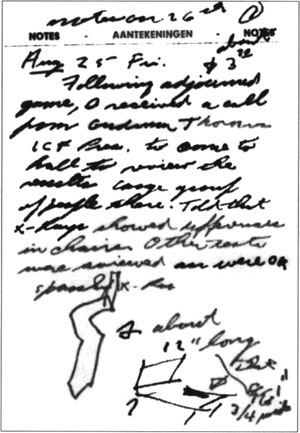 Don Schultz, former USCF President, was in Reykjavik at the time and filed the note shown on the left. It is hard to decipher reliably, but this is what it appears to say: Don Schultz, former USCF President, was in Reykjavik at the time and filed the note shown on the left. It is hard to decipher reliably, but this is what it appears to say:
"Aug 25 Fri 3:10: Following adjournment game, I received a call from Gudmundur Thrarin(sson) ICF Pres. to come to hall to review the results large group of people there. Told that X-Rays showed ??? in chairs. Other tests were reviewed and were ok."
A commendation for anyone who can do a better job of deciphering this note. Addendum: Lubomir Kavalek's wife Irena, who was with him the whole time in Reykjavik in 1972, pointed out that it says "Told that x-rays showed differences in chairs." She and mdamien in our feedback section below deserve the special commendation. |
At the time, in public, he laughed off the Soviet allegations. But later he too admitted to doubts: “Everything wasn’t fully explained.” What puzzled him was the discrepancy between the two X-rays. He was there as the second set of X-rays was developed and saw that the looplike object, the “anomaly,” as he calls it, had disappeared.
I’ve thought long about this. The only plausible thing—and it really sounds radical, and I didn’t want to mention it at the time, as I thought nobody would believe me—but I think there is a slight chance that some crackpot Russian agent—and this is really wild—some crackpot Russian agent had a plan to try to embarrass the U.S. by planting something in the chair and then making a complaint and having it found. And their security forces found out what he did and thought it was a crackpot idea, and somehow they got it out.
Move times and adjournments
Here are the times for games 16–18, as recorded by Lawrence Stevens, who visited the match in Reykjavik and jotted them down from the video screens:
|
Game 16, August 20th, 1972
Fischer Spassky
White Black
(ar) (0:09) (ar) (-:01)
1. e4 (0:09)
(Spassky appeared a minute before play was to begin. When Fischer arrived and played his move, Spassky had gone. He returned two minutes later.)
(ar) (0:02)
1. e5 (0:03)
2. Nf3 (0:09) Nc6 (0:03)
3. Bb5 (0:09) a6 (0:03)
4. Bxc6 (0:10) dxc6 (0:03)
5. 0-0 (0:10) f6 (0:04)
6. d4 (0:10) Bg4 (0:06)
7. dxe5 (0:10) Qxd1 (0:06)
8. Rxd1 (0:10) fxe5 (0:06)
9. Rd3 (0:16) Bd6 (0:06)
10. Nbd2 (0:20) Nf6 (0:07)
11. Nc4 (0:27) Nxe4 (0:11)
12. Ncxe5 (0:29) Bxf3 (0:25)
13. Nxf3 (0:31) 0-0 (0:26)
14. Be3 (0:32) b5 (0:31)
15. c4 (0:55) Rab8 (0:33)
16. Rc1 (1:06) bxc4 (0:43)
17. Rd4 (1:10) Rfe8 (0:46)
18. Nd2 (1:14) Nxd2 (0:49)
19. Rxd2 (1:14) Re4 (1:12)
20. g3 (1:25) Be5 (1:20)
21. Rcc2 (1:26) Kf7 (1:21)
22. Kg2 (1:27) Rxb2 (1:26)
23. Kf3 (1:36) c3 (1:28)
24. Kxe4 (1:36) cxd2 (1:29)
25. Rxd2 (1:36) Rb5 (1:32)
26. Rc2 (1:39) Bd6 (1:33)
27. Rxc6 (1:41) Ra5 (1:33)
28. Bf4 (1:45) Ra4+ (1:40)
29. Kf3 (1:46) Ra3+ (1:46)
30. Ke4 (1:47) Rxa2 (1:47)
31. Bxd6 (1:47) cxd6 (1:47)
32. Rxd6 (1:47) Rxf2 (1:47)
33. Rxa6 (1:47) Rxh2 (1:47)
34. Kf3 (1:51) Rd2 (1:47)
35. Ra7+ (1:58) Kf6 (1:48)
36. Ra6+ (1:58) Ke7 (1:49)
37. Ra7+ (1:58) Rd7 (1:49)
38. Ra2 (1:59) Ke6 (1:49)
39. Kg2 (2:00) Re7 (1:52)
40. Kh3 (2:02) Kf6 (1:52)
41. Ra6+ (2:05) Re6 (1:52)
42. Ra5 (2:05) h6 (1:54)
43. Ra2 (2:07) Kf5 (1:55)
44. Rf2+ (2:08) Kg5 (1:55)
45. Rf7 (2:09) g6 (1:55)
46. Rf4 (2:11) h5 (1:56)
47. Rf3 (2:13) Rf6 (1:57)
48. Ra3 (2:13) Re6 (1:59)
49. Rf3 (2:18) Re4 (1:59)
50. Ra3 (2:19) Kh6 (2:02)
51. Ra6 (2:20) Re5 (2:05)
52. Kh4 (2:25) Re4+ (2:10)
53. Kh3 (2:25) Re7 (2:10)
54. Kh4 (2:30) Re5 (2:15)
55. Rb6 (2:32) Kg7 (2:15)
56. Rb4 (2:35) Kh6 (2:16)
57. Rb6 (2:35) Re1 (2:16)
58. Kh3 (2:35) Rh1+ (2:23)
59. Kg2 (2:35) Ra1 (2:23)
60. Kh3 (2:36) Ra4 (2:23)
½-½ (2:37) |
Game 17, August 22th, 1972
Spassky Fischer
White Black
(ar) (0:05)
1. e4 (0:00) d6 (0:05)
2. d4 (0:02) g6 (0:05)
3. Nc3 (0:06) Nf6 (0:09)
4. f4 (0:07) Bg7 (0:09)
5. Nf3 (0:07) c5 (0:24)
6. dxc5 (0:12) Qa5 (0:24)
7. Bd3 (0:13) Qxc5 (0:25)
8. Qe2 (0:13) 0-0 (0:30)
9. Be3 (0:14) Qa5 (0:32)
10. 0-0 (0:16) Bg4 (0:34)
11. Rad1 (0:50) Nc6 (0:35)
12. Bc4 (0:56) Nh5 (0:53)
13. Bb3 (1:12) Bxc3 (0:54)
14. bxc3 (1:12) Qxc3 (0:54)
15. f5 (1:17) Nf6 (1:07)
16. h3 (1:39) Bxf3 (1:17)
17. Qxf3 (1:39) Na5 (1:21)
18. Rd3 (1:42) Qc7 (1:31)
19. Bh6 (1:48) Nxb3 (1:32)
20. cxb3 (1:48) Qc5+ (1:38)
21. Kh1 (1:49) Qe5 (1:38)
22. Bxf8 (1:52) Rxf8 (1:38)
23. Re3 (2:01) Rc8 (1:39)
24. fxg6 (2:03) hxg6 (1:39)
25. Qf4 (2:04) Qxf4 (1:49)
26. Rxf4 (2:04) Nd7 (1:50)
27. Rf2 (2:04) Ne5 (1:54)
28. Kh2 (2:04) Rc1 (1:57)
29. Ree2 (2:04) Nc6 (1:58)
30. Rc2 (2:05) Re1 (2:00)
31. Rfe2 (2:06) Ra1 (2:01)
32. Kg3 (2:09) Kg7 (2:01)
33. Rcd2 (2:12) Rf1 (2:05)
34. Rf2 (2:14) Re1 (2:06)
35. Rfe2 (2:15) Rf1 (2:06)
36. Re3 (2:15) a6 (2:11)
37. Rc3 (2:18) Re1 (2:13)
38. Rc4 (2:18) Rf1 (2:16)
39. Rdc2 (2:19) Ra1 (2:17)
40. Rf2 (2:23) Re1 (2:20)
41. Rfc2(s) (2:44)
(Both players arrived a minute before the resumption of the game.)
41. ... g5 (2:21)
42. Rc1 (2:49) Re2 (2:23)
43. R1c2 (2:49) Re1 (2:23)
44. Rc1 (2:59) Re2 (2:24)
45. R1c2 (2:59) Re1 (2:24)
½-½
Spassky spent 15 minutes on the position after Fischer’s 41st move. That is, 5 minutes making his 42nd move, and 10 more minutes making his 44th when the same position occurred again. Perhaps he was surprised at Fischer’s 41st move. |
Game 18, August 24-25, 1972
Fischer Spassky
White Black
(ar) (0:08)
1. e4 (0:08) c5 (0:02)
2. Nf3 (0:09) d6 (0:02)
3. Nc3 (0:09) Nc6 (0:03)
4. d4 (0:09) cxd4 (0:03)
5. Nxd4 (0:09) Nf6 (0:03)
6. Bg5 (0:10) e6 (0:04)
7. Qd2 (0:10) a6 (0:04)
8. 0-0-0 (0:10) Bd7 (0:05)
9. f4 (0:10) Be7 (0:06)
10. Nf3 (0:12) b5 (0:06)
11. Bxf6 (0:13) gxf6 (0:07)
12. Bd3 (0:18) Qa5 (0:30)
13. Kb1 (0:18) b4 (0:31)
14. Ne2 (0:19) Qc5 (0:31)
15. f5 (0:33) a5 (0:42)
16. Nf4 (0:42) a4 (0:51)
17. Rc1 (0:43) Rb8 (1:04)
18. c3 (0:54) b3 (1:17)
19. a3 (0:56) Ne5 (1:18)
20. Rhf1 (1:22) Nc4 (1:25)
21. Bxc4 (1:24) Qxc4 (1:25)
22. Rce1 (1:29) Kd8 (1:34)
23. Ka1 (1:34) Rb5 (1:35)
24. Nd4 (1:37) Ra5 (1:38)
25. Nd3 (1:40) Kc7 (1:43)
26. Nb4 (1:40) h5 (1:45)
27. g3 (1:43) Re5 (1:50)
28. Nd3 (1:44) Rb8 (1:52)
29. Qe2 (1:47) Ra5 (1:54)
30. fxe6 (1:56) fxe6 (1:54)
31. Rf2 (1:58) e5 (1:58)
32. Nf5 (2:00) Bxf5 (1:59)
33. Rxf5 (2:00) d5 (2:00)
34. exd5 (2:01) Qxd5 (2:09)
35. Nb4 (2:02) Qd7 (2:12)
36. Rxh5 (2:05) Bxb4 (2:17)
37. cxb4 (2:05) Rd5 (2:17)
38. Rc1+ (2:10) Kb7 (2:17)
39. Qe4 (2:11) Rc8 (2:18)
40. Rb1 (2:13) Kb6 (2:24)
41. Rh7 (2:14) Rd4 (2:30)
42. Qg6 (2:16) Qc6(s) (2:44)
(ar) (2:27)
(Fischer arrived 11 minutes late for the adjournment.)
43. Rf7 (2:28) Rd6
44. Qh6 Qf3
45. Qh7 (2:29) Qc6 (2:44)
46. Qh6 (2:40) Qf3 (2:44)
47. Qh7 (2:41) Qc6
½-½
(ar) indicates the player’s arrival.
(s) indicates a sealed move. |
On August 25th 1972, exactly 45 years ago, the adjournment of the 18th game ended, and Fischer still had his three-point lead. Things were getting alarming close for World Champion Spassky.

Previous articles
Bobby Fischer in Iceland – 45 years ago (1)
In the final week of June 1972 the chess world was in turmoil. The match between World Champion Boris Spassky and his challenger Bobby Fischer was scheduled to begin, in the Icelandic capital of Reykjavik, on July 1st. But there was no sign of Fischer. The opening ceremony took place without him, and the first game, scheduled for July 2nd, was postponed. Then finally, in the early hours of July 4th, Fischer arrived. Frederic Friedel narrates.
Bobby Fischer in Iceland – 45 years ago (2)
The legendary Match of the Century between Boris Spassky and Bobby Fischer was staged in the Laugardalshöllin in Reykjavik. This is Iceland’s largest sporting arena, seating 5,500, but also the site for concerts – Led Zeppelin, Leonard Cohen and David Bowie all played there. 45 years after the Spassky-Fischer spectacle Frederic Friedel visited Laugardalshöllin and discovered some treasures there.
Bobby Fischer in Iceland – 45 years ago (3)
On July 11, 1992 the legendary Match of the Century between Boris Spassky and Bobby Fischer finally began. Fischer arrived late, due to heavy traffic. To everybody's surprise he played a Nimzo instead of his normal Gruenfeld or King's Indian. The game developed along uninspired lines and most experts were predicting a draw. And then, on move twenty-nine, Fischer engaged in one of the most dangerous gambles of his career. "One move, and we hit every front page in the world!" said a blissful organiser.
Bobby Fischer in Iceland – 45 years ago (4)
7/16/2017 – The challenger, tormented by the cameras installed in the playing hall, traumatically lost the first game of his match against World Champion Boris Spassky. He continued his vigorous protest, and when his demands were not met Fischer did not turn up for game two. He was forfeited and the score was 0-2. Bobby booked a flight back to New York, but practically at the very last moment decided to play game three – in an isolated ping-pong room!
Bobby Fischer in Iceland – 45 years ago (5)
7/21/2017 – After three games in the Match of the Century the score was 2:1 for the reigning World Champion. In game four Spassky played a well-prepared Sicilian and obtained a raging attack. Fischer defended tenaciously and the game was drawn. Then came a key game, about which the 1972 US Champion and New York Times and Chess Life correspondent GM Robert Byrne filed reports. In Reykjavik chess fan Lawrence Stevens from California did something extraordinary: he manually recorded the times both players had spent on each move.
Bobby Fischer in Iceland – 45 years ago (6)
7/26/2017 – In the sixth installment of our series we offer readers a glimpse of what had been happening behind the scenes of “The Match of The Century”, especially in the Russian camp. A tense Boris Spassky, cajoled by seconds Efim Geller and Nikolai Krogius, nevertheless failed to perform to the dismay of his friends and admirers. It’s also the story of a gamble that could have hurtled Bobby down the precipice in that fateful Game 6 of the match. A cautionary tale and object lesson for aspiring players.
Bobby Fischer in Iceland – 45 years ago (7)
8/4/2017 – After the first two traumatic games World Champion Boris Spassky was leading 2-0 in the Match of the Century. But then Fischer started to play and struck back: in the next eight games he scored 6½ points, chalking up a 6.5-3.5 lead. Games 8, 9 and 10 were quite spectacular, and are the subject of today's report. Younger players will also learn about "adjournments" and how exactly "sealed moves" were handled. Some were born after these practices were abandoned.
Bobby Fischer in Iceland – 45 years ago (8)
8/9/2017 – After ten games in the World Championship match in Reykjavik, 1972, the score was 6½-3½ for Challenger Bobby Fischer. The match seemed virtually over – in the last eight games Boris Spassky had only managed to score 1½ points. "If it had been the best of 12 games, as in the Candidates matches, Spassky would already have been on his way home..." wrote Garry Kasparov in his Great Predessors book. In game 11 Boris took on the Poisoned Pawn variation of the Najdorf Sicilian, even though he had obtained a lost position in game seven. Take a look at what happened.
Bobby Fischer in Iceland – 45 years ago (9)
8/11/2017 – In game eleven of the World Championship match in Reykjavik, 1972, Boris Spassky had comprehensively outplayed the challenger in his favourite poisoned pawn variation of the Sicilian Defence. In game 12 he made a confident draw with black and Fischer realized his opponent was gaining ground. In the 13th game he abandoned the Sicilian and, to the chagrin of Spassky, played, for the first time in a top-level game – the Alekhine Defence. It turned into one of the most exciting battles of the match, and is beautifully annotated by GM Robert Byrne.
Bobby Fischer in Iceland – 45 years ago (10)
8/18/2017 – The Match of the Century was coming to a head, with Spassky, but despite all his efforts, unable to reduce the deficit. "I felt that Fischer was like a large fish in my hands," he lamented, "one that was slippery and hard to hold on to. At certain moments I let him slip. And then again the psychological torment would begin. Everything had to be begun again from the start ..." Spassky was beginning to feel despondent.
No other World Champion was more infamous both inside and outside the chess world than Bobby Fischer. On this DVD, a team of experts shows you the winning techniques and strategies employed by the 11th World Champion.
Grandmaster Dorian Rogozenco delves into Fischer’s openings, and retraces the development of his repertoire. What variations did Fischer play, and what sources did he use to arm himself against the best Soviet players? Mihail Marin explains Fischer’s particular style and his special strategic talent in annotated games against Spassky, Taimanov and other greats. Karsten Müller is not just a leading international endgame expert, but also a true Fischer connoisseur.
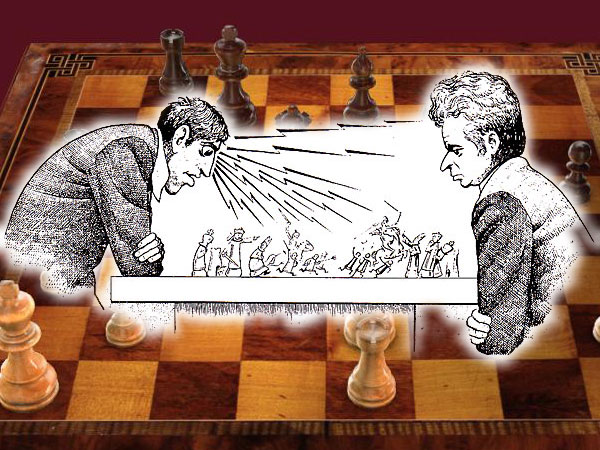


















 "Fischer chose the quiet, positional course of the Barendregt Variation of the Ruy Lopez to lead off game 16. It seemed at first as though White could count on some advantage in the endgame resulting from Black's doubled pawns, but once again Spassky came up with an interesting theoretical innovation to obtain counterplay. He achieved a plus so minute that Fischer could not be stopped from forcing a well-known drawn Rook-and-pawn ending with two pawns against one.
"Fischer chose the quiet, positional course of the Barendregt Variation of the Ruy Lopez to lead off game 16. It seemed at first as though White could count on some advantage in the endgame resulting from Black's doubled pawns, but once again Spassky came up with an interesting theoretical innovation to obtain counterplay. He achieved a plus so minute that Fischer could not be stopped from forcing a well-known drawn Rook-and-pawn ending with two pawns against one.
 In Moscow, at the end of July, apprehension over Spassky’s performance was running at a high level... There is a proposal to send the champion Kogitum—a medicine against nervous tension—and some exasperation at his refusal to take it. One report to have reached the KGB was that Fischer was being assisted by a computer (in Russian called an IBM—a Soviet tribute to American big business) and a device in his chair. There have already been reports in the Western press of Fischer being computer aided, reports derisively dismissed in Reykjavik by Spassky, Geller, and Krogius. Back in Moscow, the KGB does not believe silicon-based shenanigans are any more practical. A Comrade Lvov, a KGB technical officer, explains to the deputy minister that Fischer would have needed a full year to develop the requisite computer program and would have to have a portable receiver and a membrane in his ear to receive the signals.
In Moscow, at the end of July, apprehension over Spassky’s performance was running at a high level... There is a proposal to send the champion Kogitum—a medicine against nervous tension—and some exasperation at his refusal to take it. One report to have reached the KGB was that Fischer was being assisted by a computer (in Russian called an IBM—a Soviet tribute to American big business) and a device in his chair. There have already been reports in the Western press of Fischer being computer aided, reports derisively dismissed in Reykjavik by Spassky, Geller, and Krogius. Back in Moscow, the KGB does not believe silicon-based shenanigans are any more practical. A Comrade Lvov, a KGB technical officer, explains to the deputy minister that Fischer would have needed a full year to develop the requisite computer program and would have to have a portable receiver and a membrane in his ear to receive the signals.

 Don Schultz, former USCF President, was in Reykjavik at the time and filed the note shown on the left. It is hard to decipher reliably, but this is what it appears to say:
Don Schultz, former USCF President, was in Reykjavik at the time and filed the note shown on the left. It is hard to decipher reliably, but this is what it appears to say:
